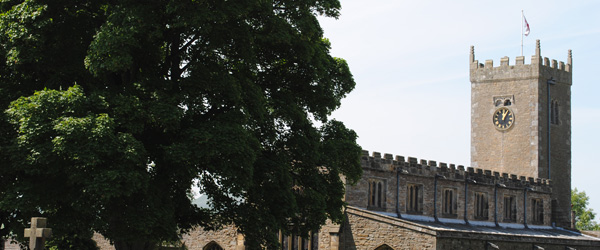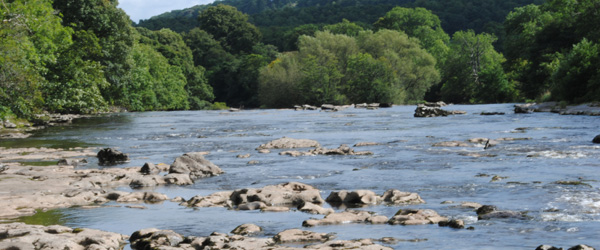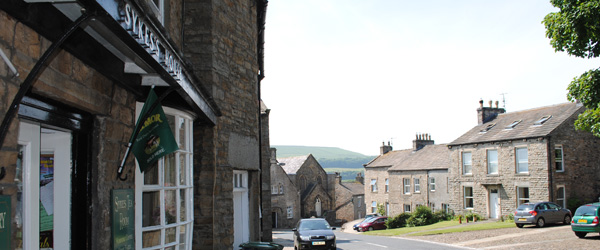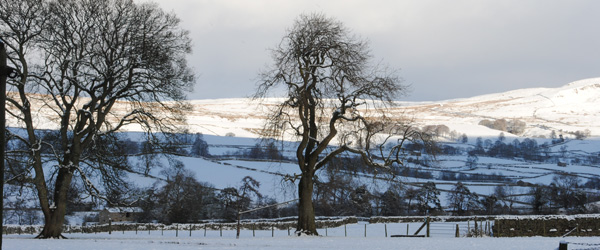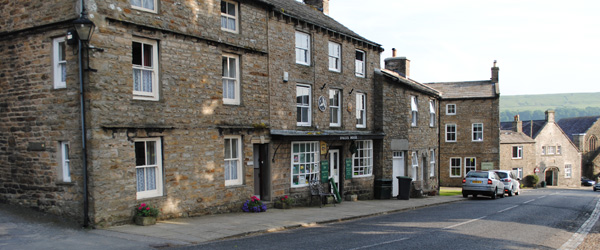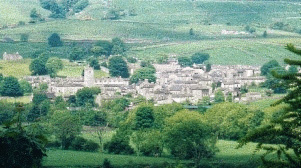
Sykes House was built in 1687 and it retains many of its original features including the stone spiral staircase, exposed beams and fireplaces. On the front of the building can be seen the Winged Wheels of the Cycling Touring Club, more information can be read below but we do know that around 1888 our plaque was placed and members then knew that they would be welcome to stop during their journey and have refreshments. The building was a Temperance Hotel at this time, so consequently, only tea, coffee and soft drinks would be served.
Sykes House has always had a retail history, originally tea was traded, it then became a municipal shop before becoming a temperance hotel and then a large family home. These owners of Sykes House opened up their living room as a shop to serve the local community and it has grown into the store it is today along with the Tea Room and B&B.
The cottage next door to the shop was not built until the late 1700’s, there used to be stone steps outside that led up to a hatch that is now behind the bread shelf. People would approach outside and whilst remaining on their horses would be served refreshments (mainly ale) through the hatch.
Askrigg is a wonderful village in the heart of the Yorkshire Dales National Park, it has a rich history as a former market town, but in more recent years it has become famous for its role as the fictional Darrowby in the BBC TV series All Creatures Great and Small. Fans may recognize Cringley House as Skeldale House and The Kings Arms being the Drovers Arms in the series. Askrigg also boasts three pubs (The Kings Arms, The White Rose and The Crown) that all serve excellent food and drinks, the local church of St Oswald which was erected about 1466, a deli, a hairdressers and of course a tea room and general store.
The name Askrigg is of Old Norse origin meaning the ridge where ash trees grew,denoting the existence of Viking settlers and their farming. The oldest settlement probably dates back to the Iron Age.
A HISTORY OF THE WINGED WHEELS
The badge of the Cyclists’ Touring Club adorns buildings all over the country. To the ordinary member today their presence may seem surprising: why should the symbol of a small club crop up in such a way and, indeed, be manifested in such relatively extravagant signs? The 24in-diameter cast-iron “wheels” are pretty heavy and usually they are firmly bolted to the masonry of the buildings they adorn – which is of course why they are still there after a hundred years. Other than deliberate monuments and some buildings, very few such casual artefacts of the late Victorian era remain today.
The wheels were obviously expensive to manufacture, and probably even more so to distribute and affix, and are a small tribute to the vision and power of the early management of the Club. They date from the era when the bicycle was the fastest form of road transport, that brief period following its maturity as an invention and before it was swamped by the motor car.
The new ‘safety bicycle’ of the 1880s and 90s increased the popularity of cycling among the richer and more leisured professional classes, making it more accessible to those who had been unwilling or unable to use the earlier High Ordinaries. The expectations of this class were higher, and their influence and spending power carried weight. They demanded, and got, a system of hotel and inn grading and discounts long before the AA came into existence and instituted its `star’ ratings. Stanley Cotterell himself set up the first network of hotels after some false starts in 1879, six months after his founding of the CTC. He enlisted members’ help and appointed regional officials who were later to be known as Consuls. By 1881 he had 785 establishments under contract, and proprietors jumped to enter into contracts with the CTC, offering fixed tariffs, reserved rooms and exclusive lounges for cyclists to use.
It was not until 1888 that the Club devised and placed its 2ft-diameter wheel on buildings as evidence that they were ‘CTC appointments’. Until that time proprietors had often made their own signs, opening up the possibility of fraud. Such was the competition for appointment that jealousy between establishments was often in evidence relating to the awarding of the coveted `Headquarters’ – meriting tariff A, or `Quarters’ – qualifying only for tariff B. The status was clearly shown by a small tab on the sign. By 1895 these tariffs were getting difficult to maintain and the structure was revised in favour of a discount system, while plain wheel signs with no inscription were issued. The old structure was phased out between 1897 and 1899. Club archives show that by 1902 discounts were enforced only by concerted effort and that by 1908 they had disappeared.
This follows the decline of fashionable cycling and the advent of the motor car pretty accurately, although it must be said that there is not much evidence to suggest that motorists negotiated their own special terms. It must have been as true then as now that you can’t beat a cyclist for watching the pennies! The manufacture of official signs had been delayed a considerable time until 1888; the original shield emblem which dated from the formation of Cotterell’s Bicycle Touring Club had not been superseded as the Club’s badge by the daring `Winged wheel’ until
in 1886 and it presumably took a couple of years for the CTC to hit on the idea of charging hoteliers a hefty deposit for them. The cast-iron wheel nevertheless remained the property of the club – and so it remains to this day, although it might be a little difficult to enforce after all this time! Nothing is known today of the place of manufacture, but the badges were issued to be painted black with white wings and lettering.
In parallel with these appointments came the appearance of the CTC Handbook, an impressive volume in which hoteliers paid for inclusion. Appointments were also made for `Repairers’, and this is now a very rare badge. Great emphasis was placed on the inclusion of temperance hotels, a burning social issue of the time. A sign remains on Sykes House, Askrigg, which was at one time a temperance hotel.
From the beginning of the Club in 1878 it was realised that certain dangerous roads and hills needed warning signs and local groups often posted their own until in 1883 the CTC took over the matter nationally. There are still a few of these, but they have not been as durable as the hotel signs. Erected in conjunction with the old NCU – partial forerunner of today’s BCF, and then latterly alone, they were finally superseded by local authority road signs. At first, local authorities sought CTC help and, to this day, the CTC retains the same rights as the AA and RAC to erect signs.
After the heyday of the cast iron sign, several other versions have been used to indicate appointments. These are much less well documented. After the Great War, embossed copper square badges were used. These were followed by black-and-yellow enamel square signs and then similar round signs available through into the 1950s. There are still many of these in existence.
Tracing this aspect of CTC history seems a small thing. The twentieth century preoccupation with the motor car still obscures a full tribute and realisation of the role that the bicycle played in the development of modern society, paving the way for technical developments in many fields, and paving the way for the emancipation and levelling of modern society. The persistence of these signs marks a grand gesture in a particular transient point of history, and in that fleeting instant we can look back and marvel at the breadth of vision of the Club that placed them.
Keith Matthews was a member of the CTC Council and secretary of Wessex CTC at the time of writing this article which appeared in the CTC Club Magazine in June 1993. In compiling the listing of the signs and the research into their history, he acknowledges the help of the CTC archives and the responses of many interested club members and non-members around the country.




